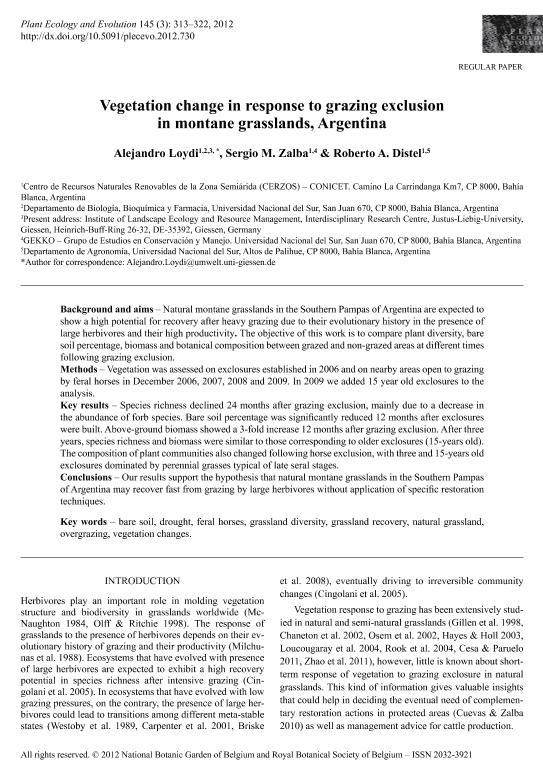Mostrar el registro sencillo del ítem
dc.contributor.author
Loydi, Alejandro

dc.contributor.author
Zalba, Sergio Martin

dc.contributor.author
Distel, Roberto Alejandro

dc.date.available
2017-07-07T15:13:49Z
dc.date.issued
2012-11
dc.identifier.citation
Loydi, Alejandro; Zalba, Sergio Martin; Distel, Roberto Alejandro; Vegetation change in response to grazing exclusion in montane grasslands, Argentina; National Botanic National Botanic Garden of Belgium and Royal Botanical Society of Belgium; Plant Ecology and Evolution; 145; 3; 11-2012; 313-322
dc.identifier.issn
2032-3913 / 2032-3921
dc.identifier.uri
http://hdl.handle.net/11336/19857
dc.description.abstract
Background and aims – Natural montane grasslands in the Southern Pampas of Argentina are expected to show a high potential for recovery after heavy grazing due to their evolutionary history in the presence of large herbivores and their high productivity. The objective of this work is to compare plant diversity, bare soil percentage, biomass and botanical composition between grazed and non-grazed areas at different times following grazing exclusion. Methods – Vegetation was assessed on exclosures established in 2006 and on nearby areas open to grazing by feral horses in December 2006, 2007, 2008 and 2009. In 2009 we added 15 year old exclosures to the analysis. Key results – Species richness declined 24 months after grazing exclusion, mainly due to a decrease in the abundance of forb species. Bare soil percentage was significantly reduced 12 months after exclosures were built. Above-ground biomass showed a 3-fold increase 12 months after grazing exclusion. After three years, species richness and biomass were similar to those corresponding to older exclosures (15-years old). The composition of plant communities also changed following horse exclusion, with three and 15-years old exclosures dominated by perennial grasses typical of late seral stages. Conclusions – Our results support the hypothesis that natural montane grasslands in the Southern Pampas of Argentina may recover fast from grazing by large herbivores without application of specific restoration techniques.
dc.format
application/pdf
dc.language.iso
eng
dc.publisher
National Botanic National Botanic Garden of Belgium and Royal Botanical Society of Belgium
dc.rights
info:eu-repo/semantics/openAccess
dc.rights.uri
https://creativecommons.org/licenses/by-nc-sa/2.5/ar/
dc.subject
Overgrazing
dc.subject
Grassland Recovery
dc.subject
Vegetation Changes
dc.subject
Natural Grasslands
dc.subject
Bare Soil
dc.subject
Grassland Diversity
dc.subject
Feral Horses
dc.subject
Drought
dc.subject.classification
Ecología

dc.subject.classification
Ciencias Biológicas

dc.subject.classification
CIENCIAS NATURALES Y EXACTAS

dc.title
Vegetation change in response to grazing exclusion in montane grasslands, Argentina
dc.type
info:eu-repo/semantics/article
dc.type
info:ar-repo/semantics/artículo
dc.type
info:eu-repo/semantics/publishedVersion
dc.date.updated
2017-07-03T14:51:46Z
dc.identifier.eissn
2032-3921
dc.journal.volume
145
dc.journal.number
3
dc.journal.pagination
313-322
dc.journal.pais
Bélgica

dc.journal.ciudad
Meise
dc.description.fil
Fil: Loydi, Alejandro. Consejo Nacional de Investigaciones Científicas y Técnicas. Centro Científico Tecnológico Conicet - Bahía Blanca. Centro de Recursos Naturales Renovables de la Zona Semiarida. Universidad Nacional del Sur. Centro de Recursos Naturales Renovables de la Zona Semiarida; Argentina
dc.description.fil
Fil: Zalba, Sergio Martin. Consejo Nacional de Investigaciones Científicas y Técnicas. Centro Científico Tecnológico Conicet - Bahía Blanca. Instituto de Ciencias Biológicas y Biomédicas del Sur. Universidad Nacional del Sur. Departamento de Biología, Bioquímica y Farmacia. Instituto de Ciencias Biológicas y Biomédicas del Sur; Argentina
dc.description.fil
Fil: Distel, Roberto Alejandro. Consejo Nacional de Investigaciones Científicas y Técnicas. Centro Científico Tecnológico Conicet - Bahía Blanca. Centro de Recursos Naturales Renovables de la Zona Semiarida. Universidad Nacional del Sur. Centro de Recursos Naturales Renovables de la Zona Semiarida; Argentina
dc.journal.title
Plant Ecology and Evolution
dc.relation.alternativeid
info:eu-repo/semantics/altIdentifier/url/http://www.ingentaconnect.com/content/botbel/plecevo/2012/00000145/00000003/art00003
dc.relation.alternativeid
info:eu-repo/semantics/altIdentifier/doi/http://dx.doi.org/10.5091/plecevo.2012.730
Archivos asociados
